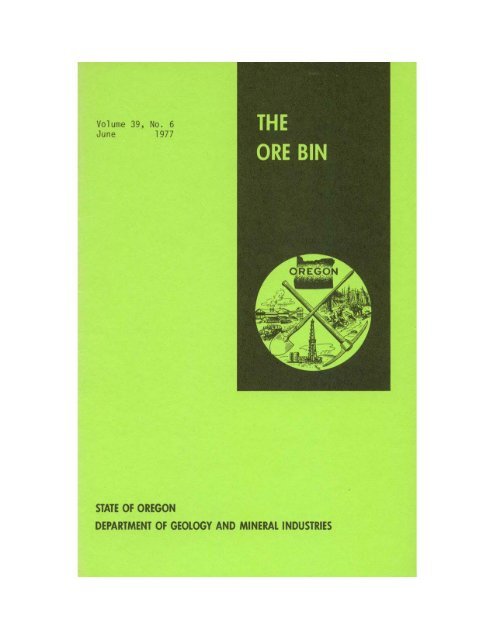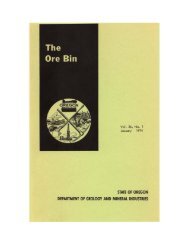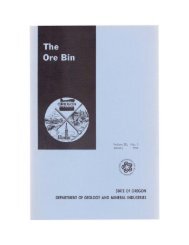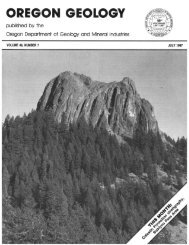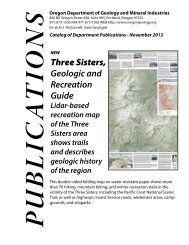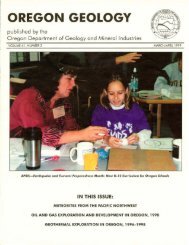Ore Bin / Oregon Geology magazine / journal - Oregon Department ...
Ore Bin / Oregon Geology magazine / journal - Oregon Department ...
Ore Bin / Oregon Geology magazine / journal - Oregon Department ...
Create successful ePaper yourself
Turn your PDF publications into a flip-book with our unique Google optimized e-Paper software.
Volume 39, No . 6<br />
June 1977<br />
STATE OF OREGON<br />
DEPARTMENT OF GEOLOGY AND MINERAL INDUSTRIES
steep gradients. A series of terraces and alluvial fills extend<br />
from the mouth of Canal Creek to Dry Gulch, and bed rock is not<br />
exposed in the lower 2 miles of Dry Gulch. As the stream in Dry<br />
Gulch flows on the surface only during periods of excessive runoff,<br />
mining and prospecting operations have been generally curtailed<br />
throughout the summer months.<br />
<strong>Geology</strong><br />
The bed rock qf the Quartzville mining district is composed<br />
primarily of basalt, andesite, and rhyolite flow rock with interbedded<br />
tuffs, volcanic breccias, and scattered dacite, diorite,<br />
and basaltic intrusives. Peck and others (1964) mapped most of<br />
the rocks in the area as Oligocene to early Miocene Little Butte<br />
Volcanic Series, middle Miocene Columbia River Basalt, and middle<br />
to late Miocene Sardine Formation. Many of the rocks mapped by<br />
Peck as Sardine Formation and Columbia River Basalt are classified<br />
by Beaulieu (1974) as part of the Little Butte Formation,<br />
which he considers the most extensive bedrock unit in the area.<br />
The youngest rocks are Recent volcanic flow rock and pyroclastic<br />
debris which are found at the confluence of Quartzville and Canal<br />
Creeks.<br />
No formal names have been given to individual rock units exposed<br />
in the Quartzville area; therefore, modifiers of "lower,"<br />
"middle," and "upper" are used in describing distinguishable units<br />
in the district. The lowest unit exposed in and near the abandoned<br />
Quartzvil1e town site consists of several pyroclastic flows, tuffs,<br />
1apilli tuffs, andesite flows, and flow-banded tuffs. Resting conformably<br />
above the lowest unit is the middle unit, a 200-foot-thick<br />
rhyolite flow which thins to the west. The rhyolite is generally<br />
gray but in p1aces.has been altered to various shades of red,ye1low,<br />
and orange. Above the rhyolite is the upper unit, which consists<br />
of interbedded flows of tuff, lapi1li tuff, and volcanic<br />
breccia, with a few intercanyon flows of dark-green porphyritic<br />
andesite. The Recent volcanic rocks (see Checkpoint 28) lie unconformably<br />
above the older units and are basaltic in composition.<br />
Within this district are areas of propy1itic alteration surrounding<br />
small stocks, dikes, and plugs (Peck and others, 1964).<br />
Many veins follow faults and shear zones that are also present,<br />
and all of the ore mineral deposits that have been worked to date<br />
have occurred along these fissures and faults (Munts, 1976).<br />
Mining History<br />
The Quartzvil1e mining district has been the site of both<br />
hard-rock and placer mining for gold. Dr. E.O. Smith is credited<br />
with the original discovery of lode gold in the district. Jeremiah<br />
Driggs located the first claims, the White Bull and Red Bull claims,<br />
on September 5, 1863; and a mining district was organized in 1864.<br />
Several large stopes in the Lawler mine and a small stope in the<br />
Albanyminewere worked,and mills were installed in the early 1890 0's.<br />
94
Although most min ing operations ceased by 1900, hard-rock<br />
prospectors have been in the di strict almost every year s ince;<br />
and some of them have recovered sma ll quantities of gold from<br />
pockets, as Table 1 shows.<br />
Tab 1 e 1. Known hard-1'Ock mine devel.opment in the Quartzville district<br />
[ i n feet]<br />
Mine Drifts Open Sha fts Cross Rai ses Total<br />
cuts cuts<br />
A A 1 bany<br />
group 1, 500 60 1,560<br />
8 Bob & Betty 700 100 550 300 1,650<br />
D lawler 1,050 250 700 2 ,000<br />
I Riverside 303 700 1,003<br />
J Savage<br />
(Vandalia) 600 80 300 980<br />
E Snowstonn<br />
(Edson) 570 80 650<br />
F Munro 217 263 480<br />
G Paymaster 150 150<br />
C Galena 725 725<br />
H Red Hei fer 60 30 90<br />
K - Ti 11 icum &<br />
Cumtil l ie 300 300<br />
Others 690 40 370 1 , 100<br />
Total 6,080 740 180 2,298 1 ,390 10 ,688<br />
Gol d has al so been recovered from placer deposits. Gravel<br />
bars along the Quartzvi ll e Creek drainage and parts of the Middle<br />
Fork of Santi am River were pl acered in the middle 1800' s , and<br />
small-scale placer mining has continued to the present.<br />
During the depression of the early 1930's , miners us ing handplacer<br />
i ng mining equipment were able to recover enough gold to survive.<br />
Merrill and others (1937) reported that during 1935 eleven<br />
mines were being worked on three creeks in l inn County. Sma ll<br />
gol d miners in <strong>Ore</strong>gon in 1935 so ld bu llion buye rs 8,032 parcels of<br />
gold with total weight of 4,021 ou nces and value of $140, 730. Average<br />
daily gross income for all mi ners was $1 .19 per day , and their<br />
average an nual income from mining was $44 , s ince miners worked an<br />
average of 37 days per year.<br />
Tabl e 2 summarizes sma l l-scale gold placer operations in 13<br />
of <strong>Ore</strong>gon's 36 counties and in 358 creeks and dry placers in the<br />
State during 1935. The two pri nc ipal placer mining coun ti es were<br />
Jackson and Josephine . The only other counties with more than<br />
100 miners were Baker, Grant, and Douglas.<br />
95
dropped its load of sand and gravel. Imbrication<br />
(shingling or overlapping) of the rocks can<br />
be used to determine stream-flow direction. Note<br />
also that some of the bedding is abruptly terminated<br />
or truncated.<br />
[I] 0.2 7.9 The Sunnys i de Park entrance is to the ri ght.<br />
The park is located on an old river terrace<br />
known as the Green Horn Bar, which was placer<br />
mined for gold in the late 1850's and 1860's.<br />
The men working the bar were called "greenhorns"<br />
because of their lack of mining experience. In<br />
their hydraulic mining, they used Californiatype<br />
riffles in the sluice boxes, resulting in<br />
the loss of most of the gold.<br />
IT] 0.6 8.5 Across the river to your right are a series<br />
of cliff-forming basalt flows, locally named<br />
the Green Peter Basalts by the U.S. Army Corps<br />
of Engineers. These basalts are faulted and cut<br />
in some places by dikes.<br />
[I] 1.0 9.5 Note the zone of alteration in the roadcut<br />
to the left. Stop at the small turnout on the<br />
right, just before the road curves to the left.<br />
In this outcrop you are looking at the mineralization<br />
of the Quartzville mining district in<br />
miniature (see Figure 2). Notice the three<br />
types of alteration that occur here, ranging<br />
from propylitic (hydrothermal alteration that<br />
has produced epidote, chlorite, and pyrite) at<br />
the edges through argillic (alteration. producing<br />
clay minerals) to phyllic (alteration to quartz<br />
and sericite) at the center of the zone. The<br />
phyllic alteration occurs along a very narrow<br />
fracture which acted as a channel for ascending<br />
hydrothermal fluids through otherwise impermeable<br />
basalt. Dioritic and granodioritic intrusive<br />
rocks are exposed to the west (left) of this<br />
fracture. This intrusion and associated alteration<br />
are indicative of the type of hydrothermal<br />
fluid at depth that was the carrier for the mineralization<br />
in the Quartzville mining district.<br />
The zonation of alteration that you see here is<br />
present in most large mining districts, but it<br />
usually covers hundreds of feet, rather than<br />
inches, as here.<br />
[@] 2.0 11.5 Green Peter Dam. To your right is a parking<br />
area and viewpoint. Work on the dam and its<br />
reservoir lasted from 1961 to 1967. The dam,<br />
which used 1,142,000 cubic yards of concrete, is<br />
320 feet high, with deck elevation of 1 ,020 feet.<br />
98
•<br />
P'i-gure 1.<br />
and<br />
Checkpoint J . I>'T'eglllap coniaei beiW
Figure ? Che kpoint 23 . Pyrite c"ystal found in alteration<br />
zone .<br />
Figure 8. Checkpoint 35 . Snowstorm tunnel. (Photo<br />
courtesy of Albany Democrat-Herald. )<br />
102
[IT] 0.5 12.0<br />
[l?J 3.3 15.3<br />
IDJ 1.7 17.0<br />
0] 0.8 17.8<br />
[§J 1.7 19.5<br />
[§J 1. 2 20.7<br />
The reservoir holds 430,000 acre-feet of water<br />
and covers 3,720 acres of land. During construction<br />
of the dam, emery boulders were uncovered at<br />
the bottom of the river. The original emery outcrop<br />
was located by tracing emery "float" (loose<br />
boulders of emery) back to the source, 36 rivermiles<br />
up the Middle Fork of the Santiam River.<br />
Park in the pulloff to your right and look<br />
to your left at the basaltic lava flow rock which<br />
is cut by several vertical basalt dikes. The<br />
dikes, which look very much like the flow rock<br />
because of similarities in composition, can be<br />
identified by their horizontal jointing which<br />
formed perpendicular to their cooling edges.<br />
At the west end of the roadcut are southeastwarddipping<br />
basalt flows which were deformed before<br />
being covered by the younger basalt flow you can<br />
see above them. The white blebs in the basalt<br />
are amygdules (secondary quartz, calcite, or<br />
zeolite minerals that filled small cavities left<br />
in cooling lava by escaping gas bubbles).<br />
Just after crossing a small stream, the road<br />
curves to the right. In the roadcut to the left,<br />
note the orange and yellow alteration, which is<br />
due to hydrothermal processes that have altered<br />
the minerals to clay and deposited pyrite, which<br />
in turn weathered to various iron oxides (rust)<br />
(see Figure 3). Because the alteration has affected<br />
a 11 of the di fferent types of rock exposed<br />
here, you can see that it is younger than they are.<br />
You are now crossing an arm of the Green<br />
Peter Reservoir.<br />
On the right is the entrance to Whitcomb<br />
Creek Park.<br />
At the curve just past milepost 12, note<br />
the slickensides in the rocks to your left (see<br />
Figure 4). Slickensides are polished and striated<br />
(scratched) surfaces resulting from rocks<br />
moving past one another along a fault plane.<br />
This particular fault plane has been exposed to<br />
weathering; therefore the striations and polish<br />
are not as distinct as those on a freshly exposed<br />
surface.<br />
Note the alteration zone with abundant iron<br />
staining. This area and the associated riverbank<br />
(now under water) are known locally as the Donnaca<br />
Bar, the site of some large placer-mining operations<br />
in the late 1890's and again in the 1930's.<br />
Several thousand dollars in gold was removed from<br />
103


